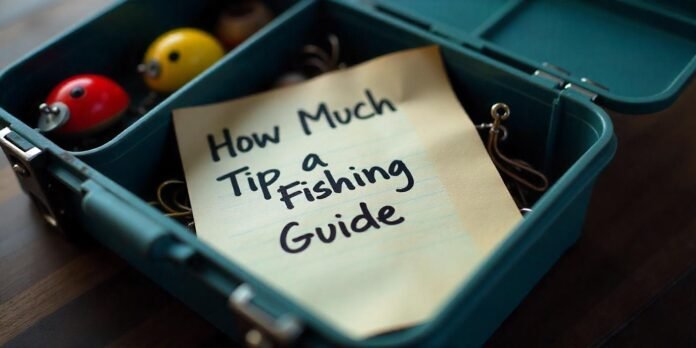Tipping a fishing guide is a standard practice and an important way to show appreciation for their hard work and expertise. While tipping amounts can vary based on location, trip length, and the level of service provided, following standard industry etiquette ensures you properly compensate your guide.
Why Tipping Matters
Fishing guides put in a lot of effort behind the scenes. From preparing gear, scouting locations, and ensuring a smooth trip, their job extends beyond just helping you catch fish. A fair tip acknowledges their dedication and helps maintain high-quality service. Guides also rely on tips as a significant portion of their income, making gratuity an essential aspect of the profession.
Step-by-Step Guide to Tipping Your Fishing Guide
Step 1: Understand the Standard Tipping Percentage
- The industry standard tip for a fishing guide is 15–20% of the trip cost.
- If the guide provided exceptional service, you may consider tipping 25% or more.
- If the service was subpar, a smaller tip of 10% is acceptable but should still reflect appreciation for their efforts.
- For budget-conscious anglers, at least a minimum of $10–$20 per person is recommended.
Step 2: Consider the Type of Fishing Trip
Tipping varies depending on the type of trip. Here’s a breakdown:
Private Charters
- Full-day private charter: Tip $100–$200, depending on the total cost of the trip.
- Half-day private charter: Tip $50–$100.
- Multi-day trips: Tip $200–$500 or more, considering the extended service.
Group Fishing Trips
- On shared or party boats, a tip of $20–$50 per person is customary, depending on the service level and trip duration.
- Some groups pool their tips to give the captain and crew a collective gratuity.
Guided Excursions (Freshwater or Fly Fishing)
- A full-day guided trip usually merits $50–$100 per angler.
- Half-day excursions typically warrant $25–$50 per angler.
- Multi-day guided fishing trips may require $100–$300 in gratuity, depending on the quality of service.
Step 3: Assess the Service Quality
- Exceptional Service: If your guide was knowledgeable, friendly, and went the extra mile, tipping above 20% is a great way to acknowledge their efforts.
- Standard Service: If the guide met expectations and provided a good experience, stick to the 15–20% range.
- Subpar Service: If the guide was inattentive or unhelpful, a tip of 10% or less may be appropriate, but it is good etiquette to at least leave something.
Step 4: Decide How to Distribute the Tip
- On private charters, tips are typically split between the captain and crew.
- If a deckhand was particularly helpful, consider giving them a small extra tip directly.
- For guided excursions, the tip usually goes directly to the guide.
- Some larger fishing operations have tip-sharing policies, so it’s best to ask beforehand.
Step 5: Check Local Customs
- In most fishing destinations, tipping is customary and expected, especially in the U.S., Mexico, and popular sportfishing locations.
- In some international locations, tipping customs may vary. It’s a good idea to check with local fishing operators beforehand.
- In certain areas, a small gift or token of appreciation in addition to a cash tip may be culturally appropriate.
Common Questions About Tipping Fishing Guides
How much should I tip my fishing guide?
The general rule is 15–20% of the trip cost, but tipping more is appreciated for outstanding service.
Should I tip if the fishing trip wasn’t successful?
Yes, guides work hard regardless of the catch. They provide valuable expertise, boat maintenance, and effort to find fish, which deserves recognition. However, if service was poor due to attitude or lack of effort, a smaller tip may be appropriate.
Do I tip the captain separately from the deckhand?
On chartered trips, tips are typically split between the captain and crew. If the deckhands went above and beyond, an extra tip given directly to them is a nice gesture.
What is the standard tip percentage for a fishing guide?
Most anglers tip 15–20% of the trip’s cost, but it can range from 10–25% based on service quality.
Are tips expected in all fishing destinations?
In most fishing destinations, tipping is customary and expected, especially in the U.S., Mexico, and popular sportfishing locations. In some international destinations, tipping practices may vary, so checking local customs in advance is recommended.
What if I can’t afford to tip?
If you are on a tight budget but still want to show appreciation, consider tipping a smaller amount along with verbal gratitude. Writing a positive review or referring the guide to others can also be a meaningful way to give back.
Additional Tips on Showing Appreciation
- Provide a verbal thank-you and express appreciation for their hard work.
- Write a positive review on Google, TripAdvisor, or fishing forums to help them attract more clients.
- Offer a small token of appreciation, such as fishing gear, snacks, or beverages, if appropriate.
- Refer your guide to friends, family, or social media networks to support their business.
Final Thoughts
Tipping is a great way to show appreciation for your guide’s knowledge, effort, and hospitality. Following a step-by-step approach to tipping ensures fairness and acknowledges excellent service. While 15–20% is the industry standard, recognizing exceptional service with a generous tip helps support hardworking guides and enhances the overall fishing experience. Additionally, small gestures like positive reviews and word-of-mouth referrals can go a long way in expressing gratitude beyond just money.


